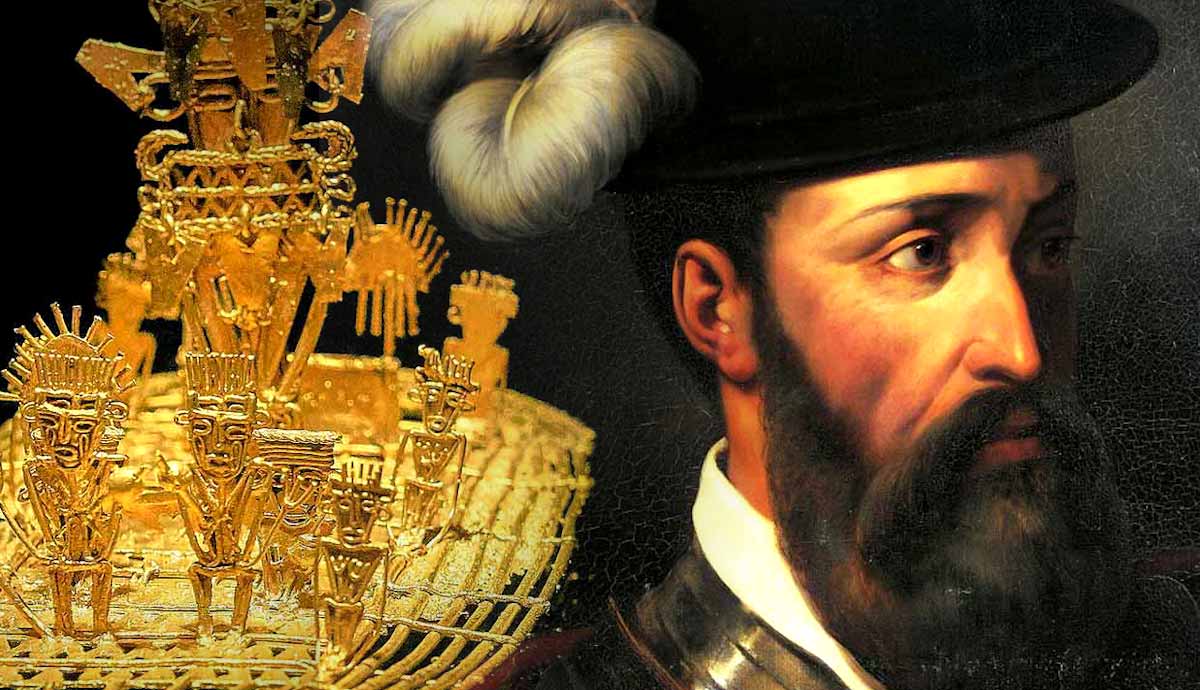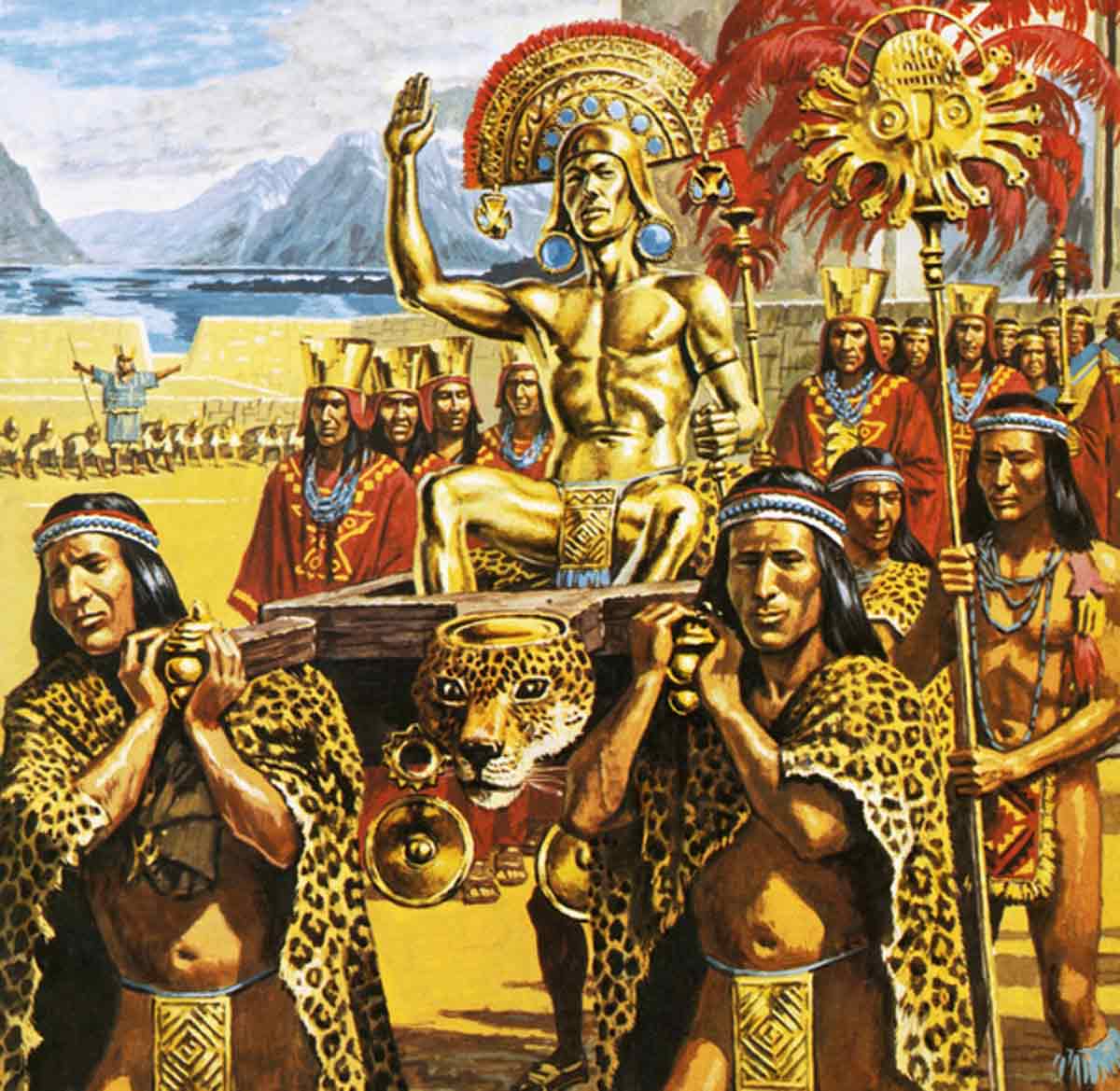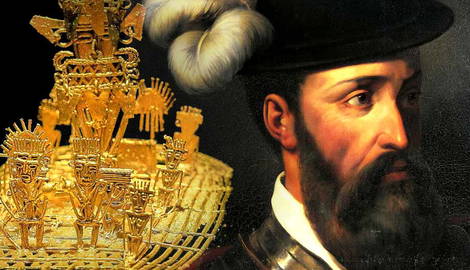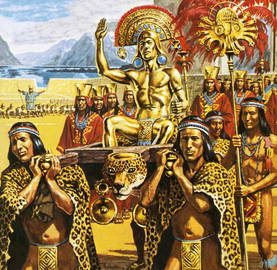
Since early Spanish colonial chronicles of the 16th century first alleged the existence of a lost city of gold in the depths of the South American continent, El Dorado has fired the imagination of explorers, scholars, and historians worldwide. What began with chroniclers’ secondhand accounts of a Muisca king bathed in gold in the Colombian Andes soon took on a life of its own as myth and legend, fueling numerous expeditions by gold-crazed explorers through the centuries. But where does history end and myth begin in the legend of El Dorado?
Origin Story: The Golden King of the Muisca

For millennia before the Spanish first landed in the territory of what is today Colombia, the northern end of South America was inhabited by diverse Indigenous societies, each with its own culture, language, identity, and social structures. In the Andean highlands of the modern-day Colombian departments of Cundinamarca and Boyacá, an Indigenous civilization known as the Muisca (also called the Chibcha) flourished beginning between 1270 BCE and 500 BCE, establishing a far-reaching and socially complex network of settlements called the Muisca Confederation.
As in many other Indigenous populations throughout the Americas—namely the Inka, who flourished further south along the Andes in what are today Ecuador, Peru, Bolivia, and Chile—gold held important religious, symbolic, and ritual significance within Muisca culture. Gold was mined and worked extensively by Muisca artisans, and frequently employed in handicrafts and religious iconography. An iconic example of Muisca goldwork—and today, a national emblem of Colombia exhibited prominently in the Museo del Oro (Gold Museum) in Bogotá—is the Muisca raft, a votive offering in the form of a raft made in an alloy of gold, silver, and copper.
This brilliant piece of pre-Columbian art offers some clues into the prominence of gold within Muisca religion and mythology—and represents one of the historical foundations of the myth of El Dorado. According to legend, one of the rulers of the Muisca Confederation, known as the zipa, would inaugurate his rule through a ritual taking place at Lake Guatavita, high in the central Colombian Andes. The new zipa would be anointed with gold dust, taken aboard a raft onto the lake, and would throw gold objects into the lake as an offering to the gods. He would then immerse himself into the lake, washing the gold from his body, to emerge from the lake reborn from the divine sun as the new ruler of the Muisca. Historically, then, “El Dorado” refers not to a city but to a man—the golden king of the Muisca.
From History to Myth: The Birth of the El Dorado Legend

When the Spanish began their decades-long conquest of Colombia beginning in the early 16th century, they encountered a land already dense with highly developed civilizations such as the Muisca, as well as the smaller chiefdoms, tribes, and bands that populated the peripheries of those socially complex confederations. What was common to a great many of those societies, however, was their abundant use of gold for artisanal and religious purposes. It was this that fueled both the rapid conquests of the gold-crazed Spanish conquistadors and the accounts of El Dorado that fired their imaginations—and their typically ill-fated expeditions—for centuries to come.
There are six original accounts that gave rise to the legend of El Dorado. Three were written by the early Spanish chroniclers Gonzalo Fernández de Oviedo, Pedro Cieza de León, and Juan de Castellanos. The other three were recorded by the conquistadores Gonzalo Pizarro, Gonzalo Jiménez de Quesada, and Sebastián de Belalcázar. While these accounts each differ in the details, they all feature the same basic story of the Muisca zipa adorned in gold and the ceremony at Lake Guatavita. These six accounts are the basic foundation of all subsequent versions of the legend of El Dorado, which was embellished with each retelling and soon took on a life of its own.

As the El Dorado narrative underwent transformation, partly a consequence of the rapid speed of the conquest and the highly mobile lives of conquistadors, chroniclers, and colonial administrators, the concept became synonymous with a lost city of gold located somewhere in the South American hinterland. Some versions even extended the concept to include a kingdom of gold, containing the mythical cities of Manoa and Omagua. The rumored location of these cities appear in various spots on colonial-era maps, with the most common placements in the river valleys of the Amazon and the Orinoco, South America’s two largest river basins. There in the depths of the great South American rainforests, explorers fruitlessly sought

Searching for El Dorado: Early Expeditions

One of the earliest European expeditions in search of El Dorado was led by Gonzalo Pizarro, the half-brother of the conquistador Francisco Pizarro, who led the conquest of the Inka Empire. Infamous for his brutality, which exceeded that of even his brother and other ruthless conquistadors of the early Spanish conquests, Gonzalo Pizarro was appointed vice-governor of Quito in 1539. He was then ordered to head east from Quito to explore the interior of modern-day Ecuador in search of the rumored kingdom of El Dorado. Assembling an expedition of several hundred Spanish troops and thousands of Indigenous men, Pizarro crossed the Andes in early 1541 and marched into the Amazonian lowlands along the course of the Coca and Napo rivers.
With provisions running low and disease rampant, Pizarro commanded his subordinate, the conquistador Francisco de Orellana, to sail downriver in search of food before rejoining the company. When Orellana failed to return—instead opting to continue downriver, becoming the first European to explore the length of the Amazon River—Pizarro accepted defeat and marched back to Quito with his few remaining men, mosquito-bitten, arrow-shot, and half-starved. The first expedition to El Dorado was a failure, one which set the precedent for all subsequent expeditions. Meanwhile, while Orellana never found El Dorado on his months-long trip down the Amazon, he eventually returned to Spain telling tales of huge, complex, and ancient civilizations flourishing along the banks of the world’s largest river, fueling the legend for years to come.
New expeditions were mounted throughout the 16th century. Conquistadors such as Gonzalo Jiménez de Quesada, his brother Hernán Pérez de Quesada, Pedro de Ursúa, and Lope de Aguirre all made their attempts, launching expeditions inland from modern-day Colombia, Peru, and Venezuela. While all ended in defeat—and often the deaths of most of the explorers—these expeditions did extend Spanish power, at least partially, further into the remote interior of the Amazon and Orinoco river basins.
Sir Walter Raleigh’s Search for the City of Gold

Perhaps the most famous of all El Dorado expeditions were those led by the English explorer and soldier Sir Walter Raleigh, taking place in the context of the Anglo-Spanish War of 1585–1604. In 1595, Raleigh sailed to the island of Trinidad just off the coast of modern-day Venezuela with the objective of capturing the Spanish settlement of San José de Oruña, along with its governor, the Spanish official Antonio de Berrío, who was also searching for El Dorado. Raleigh captured de Berrío and, with the Spaniard’s guidance, sailed 400 miles into the Orinoco River basin in search of the fabled city of gold. While he eventually reached the Guiana Highlands and established contact with several Indigenous communities of the region, he found no gold and was eventually forced to return to England, where he published an embellished account of his journey that soon inspired other explorers to try their luck.
The 1595 expedition was not to be Raleigh’s last. Raleigh’s final attempt occurred in 1617, this time under orders from King James I of England to avoid any conflict with the Spanish; a peace treaty had since been signed between the two powers. Again using the island of Trinidad as his base, Raleigh opted to stay on the island and send ahead his subordinate, an English captain named Lawrence Kemys. Kemys sailed down the Orinoco and, disobeying orders, sacked the Spanish settlement of Santo Tome de Guayana. When Spanish forces retaliated, Raleigh’s son Watt was killed in the fighting. Kemys soon returned to Raleigh with no gold and begging for forgiveness; when Raleigh refused to give any, Kemys committed suicide. Raleigh himself would fare no better; returning to England in 1618, King James ordered him executed for disobeying his orders not to engage in conflict with the Spanish.
Despite Raleigh’s ill-fated expeditions, the legend of the golden city did not die with him, and his exaggerated accounts of his explorations in the Guianas only bolstered European interest in El Dorado. His expeditions also had the effect of permanently weaking Spanish influence in the Guianas, allowing other European powers—among them the English, the Dutch, and the French—to establish colonies in the region, permanently altering the history of the northeastern corner of South America.
The Search Continues: Later Expeditions

Despite the failure of all previous expeditions in search of El Dorado, new ones were launched by several European powers throughout the 17th and 18th centuries. In 1603, Portuguese explorer Pêro Coelho de Sousa sought El Dorado in the rainforests north of the Brazilian state of Pernambuco, while in 1609 the English explorer Robert Harcourt made another attempt in the Guianas. Further expeditions occurred under other explorers in 1611, 1627, 1637, and even well into the 18th century.
Many of these expeditions centered on a huge mythical lake along which El Dorado was said to stand, Lake Parime. Based on the reports of the expeditions recounted above, European cartographers began to include Lake Parime and El Dorado itself on maps of South America, which convinced many explorers that the existence of both had been confirmed. The first map to include both sites was published by the Dutch cartographer Jodocus Hondius in 1598, based on Raleigh’s embellished narrative of his first expedition. This map inspired other cartographers to include the fabled lake on their own maps, a practice that continued into the 18th century—although no one had ever seen the lake and the city of gold which was usually placed on its northern shore.

Only by the late 18th century did most cartographers begin to leave the lake off their maps due to the failure of all attempts to confirm its existence. In 1804, the existence of Lake Parime was definitively disproved by the German explorer Alexander von Humboldt, who surveyed the region and found no lake. Humboldt instead proposed that the seasonal flooding of the Rupununi savannah in Guyana may have been mistaken for a lake. Still, the long-held belief in this nonexistent lake was partly responsible for the numerous doomed expeditions in search of El Dorado that Raleigh’s account and others inspired.
The End of the Legend?

By the early 19th century, most scholars and historians came to consider the existence of El Dorado to be a myth—albeit one that had cost many ill-fated explorers their lives and fortunes. By the turn of the 20th century, the existence of El Dorado was well and truly discredited. From its origin in the rituals of the Muisca to the dozens of doomed expeditions it inspired throughout the colonial era, the long-sought lost city of gold has returned to the realm of myth and legend.
However, the historical and cultural influence of the legend of El Dorado lives on, especially in the South American lands where so many sought in vain for the city of gold. Expeditions in search of El Dorado no longer take place, but the lust for gold has not abated; gold mining remains a major—and often illegal, dangerous, and environmentally disastrous—industry in much of South America, especially throughout the Amazon and Orinoco river basins.
The explorers of the colonial era may have never found their gold, but today illegal gold mining brings riches to some while ravaging communities and ecosystems throughout South America. For those today immersed in this dirty business, perhaps the dream of El Dorado never died…











